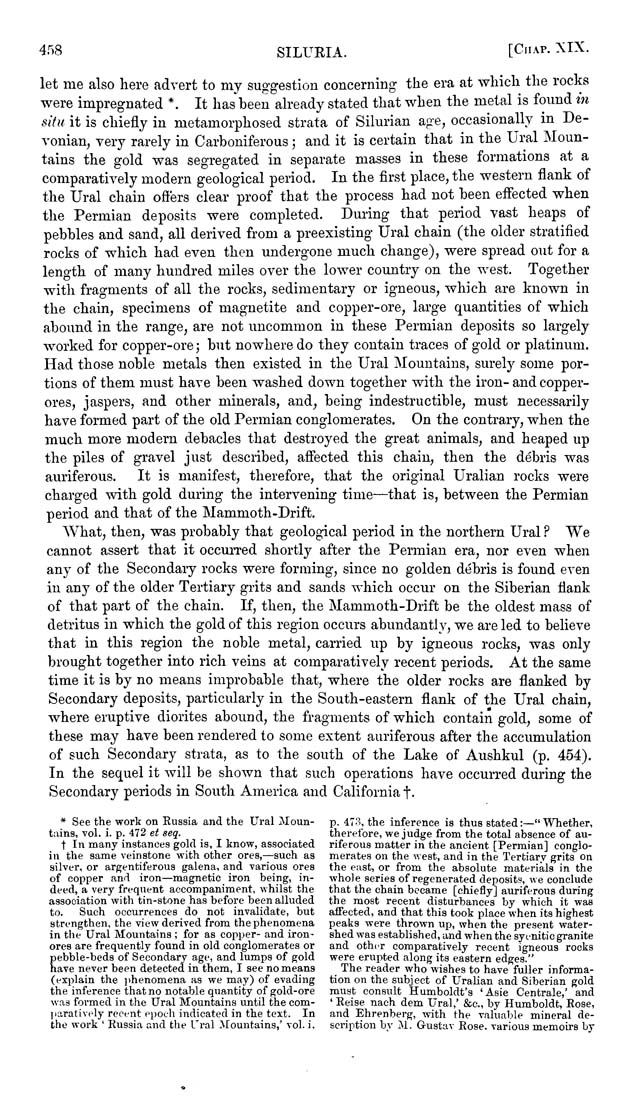458 SILURIA. [Chap. XIX.
let me also here advert to my suggestion concerning the era at which the rocks
were impregnated *. It has been already stated that when the metal is found m
situ it is chiefly in metamorphosed strata of Silurian age, occasionally in De¬
vonian, very rarely in Carboniferous ; and it is certain that in the Ural Moun¬
tains the gold was segregated in separate masses in these formations at a
comparatively modern geological period. In the first place, the western flank of
the Ural chain offers clear proof that the process had not been eflected when
the Permian deposits were completed. Dm-ing that period vast heaps of
pebbles and sand, all derived from a preexisting Ural chain (the older stratified
rocks of which had even then undergone much change), were spread out for a
length of many hundred miles over the lower country on the west. Together
with fragments of all the rocks, sedimentary or igneous, which are known in
the chain, specimens of magnetite and copper-ore, large quantities of which
abound in the range, are not uncommon in these Permian deposits so largely
worked for copper-ore; but nowhere do they contain traces of gold or platinum.
Had those noble metals then existed in the Ural Mountains, surely some por¬
tions of them must have been washed down together with the iron- and copper-
ores, jaspers, and other minerals, and, being indestructible, must necessarily
have formed part of the old Permian conglomerates. On the contrary, when the
much more modern debacles that destroyed the great animals, and heaped up
the piles of gravel just described, afiected this chain, then the debris was
auriferous. It is manifest, therefore, that the original Uralian rocks were
charged with gold during the intervening time—that is, between the Permian
period and that of the Mammoth-Drift.
What, then, was probably that geological period in the northern Ural ? We
cannot assert that it occmred shortly after the Permian era, nor even when
any of the Secondary rocks were forming, since no golden debris is found even
in any of the older Tertiary grits and sands which occur on the Siberian fiank
of that part of the chain. If, then, the Mammoth-Drift be the oldest mass of
detritus in which the gold of this region occurs abundantly, we are led to believe
that in this region the noble metal, carried up by igneous rocks, was only
brought together into rich veins at comparatively recent periods. At the same
time it is by no means improbable that, where the older rocks are fianked by
Secondary deposits, particularly in the South-eastern fiank of the Ural chain,
where eruptive diorites abound, the fragments of which contain gold, some of
these may have been rendered to some extent auriferous after the accumulation
of such Secondary strata, as to the south of the Lake of Aushkul (p. 454).
In the sequel it will be shown that such operations have occurred during the
Secondary periods in South America and California t-
* See the work on Eussia and the Ural Moun- p. 473, the inference is thus stated:—" Whether,
tains, vol. i. p. 472 et seq. therefore, we judge from the total absence of au-
t In many instances gold is, I know, associated riferous matter in the ancient [Permian] conglo-
iu the same veinstone with other ores,—such as merates on the west, and in the Tertiarv grits on
silver, or argentiferous galena, and various ores the east, or from the absolute materials in the
of copper and iron—magnetic iron being, in- whole series of regenerated deposits, we conclude
deed, a very frequent accompaniment, whilst the that the chain became [chiefly] auriferous during
association with tin-stone has before been alluded the most recent disturbances by which it was
to. Such occurrences do not invalidate, but affected, and that this took place when its highest
strengthen, the view derived from the phenomena peaks were thrown up, when the present water-
in the Ural Mountains; for as copper- andiron- shed was established, and when the syenitic granite
ores are frequently found in old conglomerates or and other comparatively recent igneous rocks
Kebble-beds of Secondary age, and lumps of gold were erupted along its eastern edges."
ave never been detected, in them, I see no means The reader who wishes to have fuller informa-
(explain the phenomena as we may) of evading tion on the subject of Uralian and Siberian gold
the inference that no notable quantity of gold-ore must consult Humboldt's 'Asie Centrale,' and
was foi'med in the Ural Mountains until the com- ' Eeise nach dem Ural,' &c., by Humboldt, Eose,
[laratively recent epoch indicated in the text. In and Ehrenberg, with the valuable mineral de-
the work ' Eussia and the Ural Mountains,' vol. i. scription by M. Gustav Eose. various memoirs by
|








